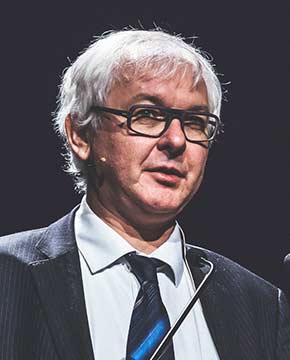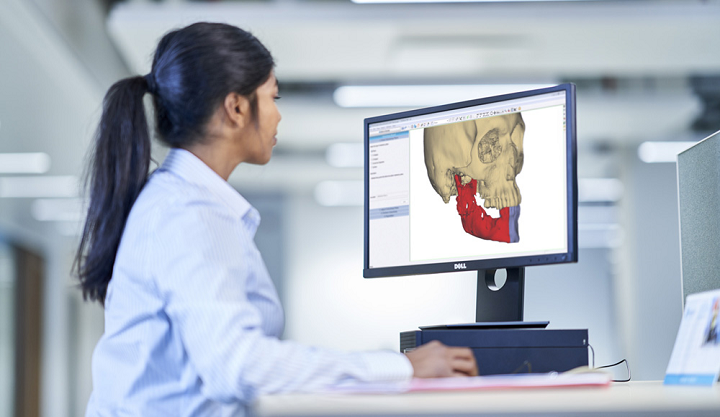With the newest release of its Magics software and its new CO-AM platform, Materialise (Nasdaq: MTLS) is demonstrating how it continues to mature with the additive manufacturing (AM) industry. On the ground at RAPID+TCT, 3DPrint.com was able to speak to Materialise CEO Wilfried Vancraen, along with Senior Marketing Director of Software Hans Van Glabeke, about the company’s role in the industrialization of AM.
The CO-AM 3D Printing Ecosystem
The company was actually planning on announcing CO-AM at the upcoming IMTS show in September. However, Materialise was spurred to launch the platform sooner when, at AMUG, Vancraen noted other companies claiming to develop what his firm had already accomplished with CO-AM. By acquiring manufacture execution systems (MES) startup Link3D, Materialise was able to move upstream into order entry and storefront functionality, as well as monitor finishing equipment and other tools outside of actual 3D printers.
Connecting all of the modules of CO-AM is a data lake, where a single customer’s data sits. While the information is the property of the client, Materialise helps to structure it for a given vertical. It can then rely on machine learning to optimize the flow and structure of this information. For instance, in the Materialise medical division, layers of a medical device or implant are captured by cameras inside of the printers. Artificial intelligence is then applied to optimize the design and printing process. This layer analysis is being ported over to other applications and is in a pilot phase.
“The idea is that with CO-AM, we create a platform where people can learn for their production lines, how to be competitive,” Vancraen told 3Dprint.com. “Some companies want to standardize AM and give everybody the same possibilities. However, if they truly succeeded, that would be deadly for the entire subcontractor industry because then you have no means to differentiate yourself anymore. By the way, they are not going to succeed because manufacturing is so broad and 3D printing has such broad applications that there is place for multiple players in this industry. However, each of the players is confronted with a challenge to optimize their systems and to create the best possible environment around their 3D printers.”
3D Printing Modules
The CO-AM software platform is agnostic with regard to the exact CAD or build preparation tools one might use. Therefore, they can rely on build prep from Materialise in the form of Magics or even GrabCAD from Stratasys. There are already third-party apps that are available for CO-AM and will continue to be more in the future. For now, they include tools from Castor, which analyzes a manufacturer’s parts to determine those best suited for AM, as well as AM-Flow, which offers solutions for tracking, grouping, and packaging parts automatically.
Among the modules connected to CO-AM is Magics. Magics is the de facto industry standard for build preparation software, allowing users to perform such functions as changing wall thickness to adding support structures to a 3D model ahead of print. With the latest edition, Magics 26, users can work with both CAD and mesh tools based on the Parasolid kernel. This means that they don’t have to go back and forth between a CAD program and Magics to cut a model into parts, or add fillets and holes.
While it’s possible to purchase individual solutions, like Magics, enterprises can also subscribe to CO-AM as a larger package configured to a specific vertical. Companies that have been using their own automated workflow to standardize the production of a specific 3D printed product, for example patient-specific hearing aids, won’t need that many additional CO-AM modules. Meanwhile, medical device and aviation manufacturers might have to rely on a broader set of different tools and workflows, as they will have a wider variety of different components to be made. They will also need to perform more planning, scheduling, and inspection.
Van Glabeke likened the model to Microsoft Office 365 versus Word. You can have access to the entire Office 365 cloud suite or just download Word for your desktop. The company is still working on a full customer portal interface in which customers can subscribe themselves and add extra modules. For now, Materialise is working to deploy CO-AM with high-end customers, otherwise the deployment costs would be too high. This will lower the threshold to traditional Magics customers.
A 3D Printing Service to Inform 3D Printing Software
Though Materialise has one of the largest 3D printing production footprints in the industry, its footprint as a software company is bigger. Why doesn’t it focus only on the software business, instead of 3D printing about 300,000 eyewear frames per year? For the experience. The firm’s service bureau business has always been an important component to understand what software it takes to 3D print good parts on a variety of systems.
“Well, we have a base in software because we believe that software is what makes 3D printers work. In order to develop the best possible software, you have to have experience about the needs of the client,” Vancraen said. “In the beginning, we started using 3D printers and discovered that we didn’t find the software that would enable us to be profitable. So, we created our own software and then decided that we would not try to become the biggest service bureau in the world, but we will try to deliver the best software to the world.”
Now that the industry is scaling up for mass production, so too is Materialise. The company aims to 3D print a million eyewear frames annually at its Polish plant so that it can solve all of the problems required to mass produce a product.
“Today, our different manufacturing activities are intended to be profitable because otherwise we would have bad software, but, at the same time, they are the testing grounds for a lot of the modules in our software. So, with eyewear, for instance, we encountered the problems of the people that have to do real big volumes,” Vancraen explained. “On the other hand, we have other lines in medical that do mass customization, where every product is unique for each patient. There, we do volumes in the tens of thousands, but not hundreds of thousands, but with much more individualization. At a certain point, we were growing in software and saw more and more demands for our metal products. So, we opened our metal factory in Bremen in order to eat our own dog food, like they say in the U.S. and to be able to experience firsthand what it’s like to be one of our customers.”
Despite the increased automation, Materialise maintains a human-centered philosophy. “We believe in the human brain to look at data, to make interpretations and so on,” Van Glabeke said.
Vancraen contributed, “From the start of Materialise, we have said that we have a mission: We want to contribute to a better and healthier world. That has multiple dimensions. One of them is planet and the other dimension is people. We like to make people happy. That’s happy customers, but also happy employees. We try to design our software tools with the people in mind. We want software that people actually like to use. And that’s one of the big challenges now in MES software. So, we want automation and artificial intelligence to make things easier for human beings.”
Ethics in 3D Printing Business
As a writer in the industry, I’ve always marveled at how Vancraen’s philosophy balances with the world of business, which is often morally questionable to say the least. Materialise is known to strive for ecological sustainability and avoids operating in weapons manufacturing whenever possible. I asked Vancraen how he navigates this complicated territory.
“[Achieving this balance means] trying to be fair in the equilibrium between different stakeholders. We have to value our people [i.e., Materialise employees]. We have to give them credit for that value. And that is something you do by paying them. But, at the same time, we will never be the richest people on earth because we cannot afford it. If we have to give one employee so much, we have to take too much from our customers,” Vancraen said.
“We have to try to create added value in everything we do. Luckily, you can create added value by also doing good for the people and for the planet. But we have to take some of that added value for ourselves. Otherwise, we cannot be sustainable. We cannot be fair to our suppliers, to our employees. So, there’s that constant urge for the right balance where everybody is treated in a fair way.”
The CEO went on to describe how that expands to its operation on the public stock market:
“We are also doing our the best we can to be transparent and fair to our shareholders. When we entered the stock market in 2014, many players in the AM industry were promising enormous growth up to 100% per year. We indicated our anticipated growth expectation to be more modest up to 20% till 2020, and we achieved a growth of 19% on average since 2013 by the end of 2019.”
As the 3D printing industry increasingly gets integrated into the broader world of mainstream production, it will be interesting to see how the company continues to navigate this area. Mass manufacturing is an area fraught with ecological and social destruction typically driven by weapons producers. Questionable supply chains rely on slave labor and the erosion of habitats, which support the biodiversity necessary for existence on earth. These supply chains, in turn, support the global military industrial complex, powered by and powering fossil fuels. In the meantime, the company will certainly empower AM’s industrialization, but, in the long run will Materialise lead the change that replaces this system or become co-opted by it?
Subscribe to Our Email Newsletter
Stay up-to-date on all the latest news from the 3D printing industry and receive information and offers from third party vendors.
You May Also Like
Profiling a Construction 3D Printing Pioneer: US Army Corps of Engineers’ Megan Kreiger
The world of construction 3D printing is still so new that the true experts can probably be counted on two hands. Among them is Megan Kreiger, Portfolio Manager of Additive...
US Army Corps of Engineers Taps Lincoln Electric & Eaton for Largest 3D Printed US Civil Works Part
The Soo Locks sit on the US-Canadian border, enabling maritime travel between Lake Superior and Lake Huron, from which ships can reach the rest of the Great Lakes. Crafts carrying...
Construction 3D Printing CEO Reflects on Being Female in Construction
Natalie Wadley, CEO of ChangeMaker3D, could hear the words of her daughter sitting next to her resounding in her head. “Mum, MUM, you’ve won!” Wadley had just won the prestigious...
1Print to Commercialize 3D Printed Coastal Resilience Solutions
1Print, a company that specializes in deploying additive construction (AC) for infrastructure projects, has entered an agreement with the University of Miami (UM) to accelerate commercialization of the SEAHIVE shoreline...

































